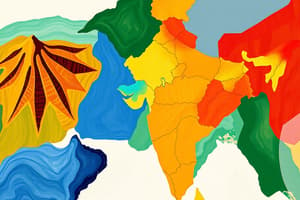Podcast
Questions and Answers
ফিজিক্যাল জিওগ্রাফির কোনটি ভূস্থির প্রধান কোণাসহ অন্যান্য কোন বিষয়গুলি নিয়ে অনুসন্ধান করে?
ফিজিক্যাল জিওগ্রাফির কোনটি ভূস্থির প্রধান কোণাসহ অন্যান্য কোন বিষয়গুলি নিয়ে অনুসন্ধান করে?
ফিজিক্যাল জিওগ্রাফির অনুসন্ধানের জন্য কোন উপায়গুলি ব্যবহার হয়?
ফিজিক্যাল জিওগ্রাফির অনুসন্ধানের জন্য কোন উপায়গুলি ব্যবহার হয়?
ফিজিক্যাল জিওগ্রাফির মোটর-এর 2 ধরন?
ফিজিক্যাল জিওগ্রাফির মোটর-এর 2 ধরন?
ফিজিক্যাল জিওগ্রাফির 'বায়া়' -র বিভিন্নো?
ফিজিক্যাল জিওগ্রাফির 'বায়া়' -র বিভিন্নো?
Signup and view all the answers
'প্রাণি' -র 'EVOLUTION' -র 2-𝑟 𝑳𝐸𝑉𝐸𝐿?
'প্রাণি' -র 'EVOLUTION' -র 2-𝑟 𝑳𝐸𝑉𝐸𝐿?
Signup and view all the answers
ভূতত্ত্বিক ভূগোলের কোন ব্যবহারে একটি গভীর অনুভূতি প্রয়োজন?
ভূতত্ত্বিক ভূগোলের কোন ব্যবহারে একটি গভীর অনুভূতি প্রয়োজন?
Signup and view all the answers
নিম্নের মধ্যে কোনটি 'নিখিল'?
নিম্নের মধ্যে কোনটি 'নিখিল'?
Signup and view all the answers
রাজনৈতিক নে�া-�া-�া-�া-�া � � � � � � � � � � � � � � � � � � � � � � � � � � � � �-�া-�া-�া-�া-�া-�া-�া-�া-�া-�া-�া-�র�া-�া-�া-�া-�া-�া-�া-�া-�া-�া � �� �� �� �� �� �� ��-�া-�া
রাজনৈতিক নে�া-�া-�া-�া-�া � � � � � � � � � � � � � � � � � � � � � � � � � � � � �-�া-�া-�া-�া-�া-�া-�া-�া-�া-�া-�া-�র�া-�া-�া-�া-�া-�া-�া-�া-�া-�া � �� �� �� �� �� �� ��-�া-�া
Signup and view all the answers
Physical Geography-ের Importance summary-র।
Physical Geography-ের Importance summary-র।
Signup and view all the answers
Study Notes
Exploring Physical Geography: Shaping Perspectives through Research and Application
Physical geography, a fundamental branch of earth sciences, encompasses the study of Earth's landscapes, atmosphere, water systems, living organisms, and their interactions. While traditionally associated with mountain ranges, rivers, coastlines, climates, and ecosystems, physical geography dives deeper into understanding these phenomena through quantitative methods, remote sensing, and sophisticated tools like Geographic Information Systems (GIS).
Key Components of Physical Geography
At the core of physical geography lies the following concepts:
- Landforms: From mountains to valleys, landforms form the bedrock of physical geography. Their composition, formation, and interaction with neighboring features shape the landscape.
- Water bodies: Rivers, lakes, glaciers, and the ocean are dynamic forces shaping continents and nurturing diverse aquatic ecosystems.
- Climates: Temperature, precipitation, wind patterns, evaporation rates, and atmospheric pressure contribute to distinct climates that influence landform evolution, vegetation distribution, and animal behavior.
- Biogeophysical cycles: Carbon, nitrogen, water, and energy flow through ecosystems via biological, chemical, and physical transfers.
- Tectonic activity: Volcanism, earthquakes, uplift, subsidence, and plate tectonics shape Earth's surface constantly, creating new habitats and driving species adaptation.
Applications of Physical Geography
Understanding physical geography leads to numerous practical applications in fields spanning from agriculture to disaster management:
- Resource management: Identifying suitable locations for mineral extraction, timber harvesting, or hydropower development requires a deep comprehension of local geological conditions.
- Natural hazard assessment: Anticipating events such as floods, volcano eruptions, or coastal storm surges involves predictable understanding of risk factors and preparedness strategies.
- Regional planning: Decision-makers rely heavily upon geographic analyses when planning economic growth initiatives, infrastructure improvements, conservation efforts, and sustainable practices.
- Disaster response: Following major disasters, rapid assessments of damaged regions require quick access to reliable georeferenced datasets to prioritize relief efforts efficiently.
- Risk communication: Visualizing risks and threats helps leaders produce clear communications, reducing confusion among stakeholders during challenging times.
Given the complexity of global challenges, physical geography plays a crucial role in addressing pressing concerns faced by societies worldwide, fostering collaborative interdisciplinary solutions involving ecologists, economists, engineers, planners, policymakers, and educators.
Studying That Suits You
Use AI to generate personalized quizzes and flashcards to suit your learning preferences.
Description
Dive into the key components and practical applications of physical geography, from understanding landforms like mountains and valleys to exploring water bodies such as rivers, lakes, and oceans. Discover how climates, biogeophysical cycles, and tectonic activities shape Earth's landscapes and drive ecosystems. Explore how physical geography influences resource management, hazard assessment, regional planning, disaster response, and risk communication.




